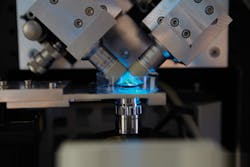SPECTROSCOPY/FLUORESCENCE MICROSCOPY/CELL BIOLOGY: Multimodal instrument reveals molecules' sub-millisecond movements in 3-D
A combination of single-molecule spectroscopy and light-sheet microscopy is enabling researchers in Heidelberg, Germany to record fast, dynamic processes in living cells that were previously invisible—and the new technique has already facilitated a discovery. The instrument depicts the fluorescence of every single pixel within view, snapping images at intervals of less than 1 ms. “It’s really visual biochemistry,” says Malte Wachsmuth, who developed the microscope at the European Molecular Biology Laboratory (EMBL). “We can follow fluorescently tagged molecules in whole live cells, in 3-D, and see how their biochemical properties, like interaction rates and binding affinities, vary throughout the cell.”
A paper published online in Nature Biotechnology1 explains how the new microscope can enable scientists to see and measure how molecules diffuse across a whole specimen, for instance—even one containing multiple cells. Standard techniques, based on confocal microscopy, limited researchers to observing at most a few isolated spots at a time.
Using the microscope to measure the interaction between chromatin and a protein called HP1-α, EMBL scientists made a discovery. Chromatin—the combination of DNA, RNA and proteins that forms chromosomes—had previously been observed in two states: wound tightly together, with most of its DNA inaccessible to the cell’s gene-reading machinery (in which case it is called heterochromatin); or loosely packed and easily readable (called euchromatin). Views afforded by the new microscope enabled the researchers to see that “in some areas that look like euchromatin, HP1-α behaves as it would in the presence of heterochromatin,” according to Michael Knop, now at the University of Heidelberg. “This suggests that chromatin may also exist in an intermediate state between hetero- and euchromatin, which was not observable before in living cells.”
The scientists say the new microscope could facilitate investigation of the role of growth hormones in cancer, the regulation of cell division and signaling, and the patterning of tissue development in the embryo, for instance—all very fast processes.
J. Capoulade et al., Nature Biotechnol., doi:10.1038/nbt.1928 (2011).
More BioOptics World Current Issue Articles
More BioOptics World Archives Issue Articles

